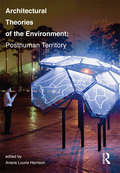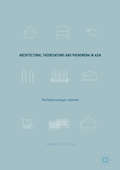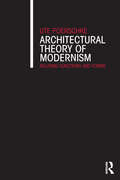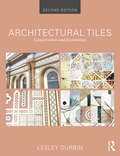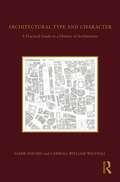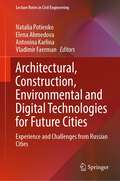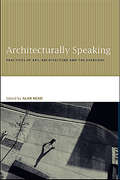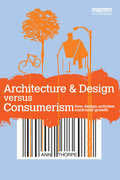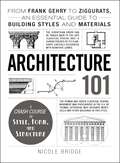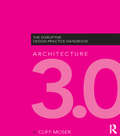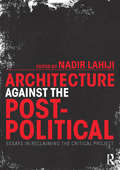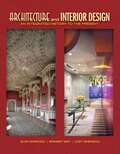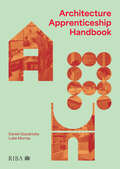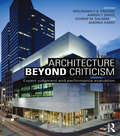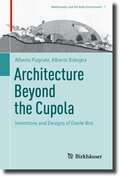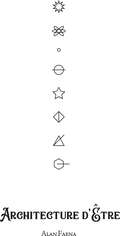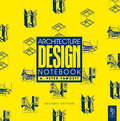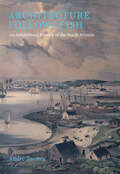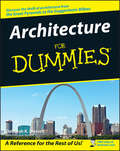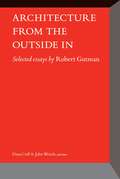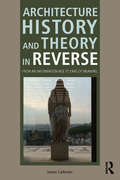- Table View
- List View
Architectural Theories of the Environment: Posthuman Territory
by Ariane Lourie HarrisonAs architects and designers, we struggle to reconcile ever increasing environmental, humanitarian, and technological demands placed on our projects. Our new geological era, the Anthropocene, marks humans as the largest environmental force on the planet and suggests that conventional anthropocentric approaches to design must accommodate a more complex understanding of the interrelationship between architecture and environment Here, for the first time, editor Ariane Lourie Harrison collects the essays of architects, theorists, and sustainable designers that together provide a framework for a posthuman understanding of the design environment. An introductory essay defines the key terms, concepts, and precedents for a posthuman approach to architecture, and nine fully illustrated case studies of buildings from around the globe demonstrate how issues raised in posthuman theory provide rich terrain for contemporary architecture, making theory concrete. By assembling a range of voices across different fields, from urban geography to critical theory to design practitioners, this anthology offers a resource for design professionals, educators, and students seeking to grapple the ecological mandate of our current period. Case studies include work by Arakawa and Gins, Arons en Gelauff, Casagrande, The Living, Minifie van Schaik, R & Sie (n), SCAPE, Studio Gang, and xDesign. Essayists include Gilles Clément, Matthew Gandy, Francesco Gonzáles de Canales, Elizabeth Grosz, Simon Guy, Seth Harrison, N. Katherine Hayles, Ursula Heise, Catherine Ingraham, Bruno Latour, William J. Mitchell, Matteo Pasquinelli, Erik Swyngedouw, Sarah Whatmore, Jennifer Wolch, Cary Wolfe, and Albena Yaneva
Architectural Theorisations and Phenomena in Asia: The Polychronotypic Jetztzeit
by Francis Chia-Hui LinThis book is the first overall and detailed discussion of contemporary Asia's architectural theorisations and phenomena based on its heteroglossic and decolonisation character. Lin presents a theoretical journey of transdisciplinary reflection upon contemporary Asia's pragmatic phenomena which is methodologically achieved by means of elaborations of how tangible Asian architecture can be philosophically theorised and how interchangeable architectural theory is practically 'Asianised'. Discussions in the book are critically integrated with comparative studies focused on Japan, Taiwan, China, Hong Kong, Singapore, Malaysia, Australia, New Zealand and the UK. These empirical examinations are highlights of phenomenal localities, architecture, cities and cultures which reference the historicity of the Asia Pacific, Asia's contemporary architectural situations, and their subtle relationship with the 'West'. The schematisation of intended 'fuzziness' for Asia and its architecture is framed as the notion polychronotypic jetztzeit to represent a present time-place context of contemporary Asian architecture and urbanism. This book will be of great interest to scholars of Asian Studies, Architectural Studies, Postcolonial Studies, Urban Studies and Cultural Studies.
Architectural Theory of Modernism: Relating Functions and Forms
by Ute PoerschkeArchitectural Theory of Modernism presents an overview of the discourse on function-form concepts from the beginnings, in the eighteenth century, to its peak in High Modernism. Functionalist thinking and its postmodern criticism during the second half of the twentieth century is explored, as well as today's functionalism in the context of systems theory, sustainability, digital design, and the information society. The book covers, among others, the theories of Carlo Lodoli, Gottfried Semper, Eugène-Emmanuel Viollet-le-Duc, Louis Sullivan, Frank Lloyd Wright, Hannes Meyer, Adolf Behne, CIAM, Jane Jacobs, Robert Venturi and Denise Scott Brown, Charles Jencks, William Mitchell, and Manuel Castells.
Architectural Tiles: Conservation And Restoration : From The Medieval Period To The Twentieth Century
by Lesley DurbinThis book aims to advise and encourage on appropriate means towards preservation of the valuable heritage. It is an accessible resource to anyone who is interested either professionally or as an enthusiast in the preservation of historic architectural tiles.
Architectural Topographies: A Graphic Lexicon of How Buildings Touch the Ground
by Tomà BerlandaArchitectural Topographies is a critical dictionary for architects and landscape architects in which the graphic lexicon can be read from a beginning, the ground, to a conclusion, the specific case studies. Meant as a tool to help you recognise, analyse, choose, and invent solutions, the book's key words refer to the physical and material relationship between construction and ground; to where and how the link is built; to the criteria, methods, and tools used to know and transform the ground; and to the possible approaches to the place and their implications on the way the earth is touched. Fifty case studies by forty-six of the greatest architects of the previous hundred years are represented throughout in sectional drawings which place the buildings along the same ground plane to illustrate how the key words might be combined and to show each architect's position on their built work in relation to all the others. Includes projects by Alvar Aalto; Tadao Ando; Gunnar Asplund; Atelier Bow-Wow; João Batista Vilanova Artigas; Patrick Berger; Mario Botta; Marcel Breuer; Erik Bryggman; Gonçalo Byrne; David Chipperfield; Le Corbusier; Sverre Fehn; Aurelio Galfetti, Flora Ruchat, and Ivo Trumpy; Dick Van Gameren; Herzog and De Meuron; Steven Holl; Arne Jacobsen; Kengo Kuma; Anne Lacaton and Jean Philippe Vassal; Adalberto Libera; Frank Lloyd Wright; Paulo Mendes da Rocha; Ludwig Mies van der Rohe; Enric Miralles and Carme Pinos; Glenn Murcutt; Juan Navarro Baldeweg; Sheila O’Donnell and John Tuomey; Jan Olav Jensen and Børre Skodvin; John Pawson; Giuseppe Perugini, Mario Fiorentino, and Nello Aprile; Renzo Piano; Georges-Henry Pingusson; Rudolph Schindler; Roland Simounet; Alvaro Siza; Luigi Snozzi; Alejandro de la Sota; Eduardo Souto de Moura; Alison Smithson and Peter Smithson; Fernando Tavora; Jørn Utzon; Livio Vacchini; Francesco Venezia, Roberto Collovà, and Marcella Aprile; Amancho Williams; and Peter Zumthor.
Architectural Type and Character: A Practical Guide to a History of Architecture
by Carroll William Westfall Samir YounésArchitectural Type and Character provides an alternative perspective to the current role given to history in architecture, reunifying architectural history and architectural design to reform architectural discourse and practice. Historians provide important material for appreciating buildings and guiding those who produce them. In current histories, a building is the product of a time, its form follows its function, irresistible influences produce it, and style, preferably novel, is its most important attribute. This book argues for an alternative. Through a two-part structure, the book first develops the theoretical foundations for this alternative history of architecture. The second part then provides drawings and interpretations of over one hundred sites from different times and places. Architectural Type and Character: A Practical Guide to a History of Architecture is an excellent desk reference and studio guide for students and architectures alike to understand, analyze, and create buildings.
Architectural Type and Character: A Practical Guide to a History of Architecture
by Carroll William Westfall Samir YounésArchitectural Type and Character provides an alternative perspective to the current role given to history in architecture, reunifying architectural history and architectural design to reform architectural discourse and practice. Historians provide important material for appreciating buildings and guiding those who produce them. In current histories, a building is the product of a time, its form follows its function, irresistible influences produce it, and style, preferably novel, is its most important attribute. This book argues for an alternative. Through a two-part structure, the book first develops the theoretical foundations for this alternative history of architecture. The second part then provides drawings and interpretations of over one hundred sites from different times and places.Architectural Type and Character: A Practical Guide to a History of Architecture is an excellent desk reference and studio guide for students and architectures alike to understand, analyze, and create buildings.
Architectural, Construction, Environmental and Digital Technologies for Future Cities: Experience and Challenges from Russian Cities (Lecture Notes in Civil Engineering #227)
by Vladimir Faerman Natalia Potienko Elena Ahmedova Antonina KarlinaThis book offers an overview of Russian and international experience in developing the concept of future cities and its practical implementation. The concept of future cities is associated with several important trends. The first trend is the sustainable development of the urban environment and the implementation of eco-friendly technologies and materials in civil construction, industrial and power plants. The harmonious coexistence of the citizens with all forms of nature in the urban habitat becomes a great value. The second trend is the individualization of the aesthetical and architectural image of the future cities. The city's unique flavor based on the blending of the historical legacy and architectural traditions is now as important as the utility of the environment. The third trend is the digitalization of the urban environment with the use of state-of-the-art sensors, information and communication technologies, and data science. The efficiency of operations and services achieved by the extensive use of complex IoT networks becomes a value as well. The last trend is the adaptation of the urban and social environment for individual demands of a community and a person. Individual comfort and safety are now more important than ever before. By addressing these trends, the volume discusses local and international plans, practices, and technologies aimed at the development and implementation of future cities.
Architecturally Speaking: Practices of Art, Architecture and the Everyday
by Alan ReadArchitecturally Speaking is an international collection of essays by leading architects, artists and theorists of locality and space. Together these essays build to reflect not only what it might mean to 'speak architecturally' but also the innate relations between the artist's and architect's work, how they are distinct, and in inspiring ways, how they might relate through questions of built form. This book will appeal to urbanists, geographers, artists, architects, cultural historians and theorists.
Architecture
by Francis D. ChingA superb visual reference to the principles of architectureNow including interactive CD-ROM!For more than thirty years, the beautifully illustrated Architecture: Form, Space, and Order has been the classic introduction to the basic vocabulary of architectural design. The updated Third Edition features expanded sections on circulation, light, views, and site context, along with new considerations of environmental factors, building codes, and contemporary examples of form, space, and order.This classic visual reference helps both students and practicing architects understand the basic vocabulary of architectural design by examining how form and space are ordered in the built environment.? Using his trademark meticulous drawing, Professor Ching shows the relationship between fundamental elements of architecture through the ages and across cultural boundaries. By looking at these seminal ideas, Architecture: Form, Space, and Order encourages the reader to look critically at the built environment and promotes a more evocative understanding of architecture.In addition to updates to content and many of the illustrations, this new edition includes a companion CD-ROM that brings the book's architectural concepts to life through three-dimensional models and animations created by Professor Ching.
Architecture & Design versus Consumerism: How Design Activism Confronts Growth
by Ann ThorpeThe mentality that consumerism and economic growth are cure-alls is one of the biggest obstacles to real sustainability, but any change seems impossible, unthinkable. Our contemporary paradox finds us relying for our well being on consumer-driven economic growth that we actually can’t afford — not in environmental, economic or social terms. Although architecture and design have long been seen as engines for consumerism and growth, increasing numbers of designers are concerned about the problems resulting from growth. But designers face a paradox of their own; in scenarios of sustainable consumption, where people consume or build significantly less, what will be left for designers to do? This book, informed by recent research into the viability of a "steady state" economy, sets an agenda for addressing the designer’s paradox of sustainable consumption. The agenda includes ways that architecture and design can help transition us towards a new kind of economy that prioritizes real wellbeing rather than economic growth. Packed with examples and illustrations, the book argues that taking action, or activism, is an important but so far underexplored way for architects and designers to confront consumerism. The first chapters explore how economic growth and consumerism shape and are shaped by the professions of architecture, product, and landscape design and how we can understand the problem of consumerism as four main challenges that designers are already addressing. The book maps out the main issues surrounding the development of metrics that designers and others can use to measure wellbeing, instead of simply measuring economic growth. The second half of the book looks at how design activism works and its connection to growth and consumerist issues. These chapters examine how activist practices are financed, highlight five specific methods that designers use in working for social change, and investigate the power of these methods. The book concludes with a consideration of what design’s role might be in a "post-growth" society.
Architecture 101
by Nicole BridgeA crash course in designing and constructing buildingsToo often, textbooks turn the noteworthy details of architecture into tedious discourse that would put even Frank Gehry to sleep. Architecture 101 cuts out the boring explanations, and instead provides a hands-on lesson that keeps you engaged as you explore the world's greatest structures.Featuring only the most important facts, building styles, and architects, you'll enjoy uncovering the remarkable world of architecture with this book. Inside, you'll also find fascinating elements like:Illustrations of popular building styles, such as Georgian and Greek RevivalDrawings of the essential parts of different buildingsUnique profiles of the most inspirational figures in architectureFrom Norman Foster and Frank Lloyd Wright to the Beauvais Cathedral and the Empire State Building, Architecture 101 is packed with hundreds of entertaining architecture tidbits that you can't get anywhere else!
Architecture 101: From Frank Gehry to Ziggurats, an Essential Guide to Building Styles and Materials
by Nicole BridgeA crash course in designing and constructing buildingsToo often, textbooks turn the noteworthy details of architecture into tedious discourse that would put even Frank Gehry to sleep. Architecture 101 cuts out the boring explanations, and instead provides a hands-on lesson that keeps you engaged as you explore the world's greatest structures.Featuring only the most important facts, building styles, and architects, you'll enjoy uncovering the remarkable world of architecture with this book. Inside, you'll also find fascinating elements like:Illustrations of popular building styles, such as Georgian and Greek RevivalDrawings of the essential parts of different buildingsUnique profiles of the most inspirational figures in architectureFrom Norman Foster and Frank Lloyd Wright to the Beauvais Cathedral and the Empire State Building, Architecture 101 is packed with hundreds of entertaining architecture tidbits that you can't get anywhere else!
Architecture 3.0: The Disruptive Design Practice Handbook
by Cliff MoserThis book provides a definitive guide for the future direction of the practice and profession of architecture. In five parts, Cliff Moser provides you with all the tools and know-how to implement changes that will serve you and your practice in the short, medium and long term. Written at a crucial time for the industry, this is essential reading for every architect.
Architecture Against the Post-Political: Essays in Reclaiming the Critical Project
by Nadir LahijiWritten by a team of renowned contributors and carefully edited to address the themes laid out by the editors in their introduction, the book includes theoretical issues concerning the questions of aesthetics and politics and addresses city and urban strategies within the general critique of the "post-political". By focusing on specific case studies from Warsaw, Barcelona, Dubai, Tokyo and many more the book consolidates the contributions of a diverse group of academics, architects and critics from Europe, the Middle East and America. This collection fills the gap in the existing literature on the relation between politics and aesthetics, and its implications for the theoretical discourse of architecture today. In summary, this book provides a response to the predominant de-politicization in academic discourse and is an attempt to re-claim the abandoned critical project in architecture.
Architecture And Interior Design: An Integrated History To The Present
by Buie Harwood Bridget May Curt ShermanArchitecture and Interior Design: An Integrated History to the Present provides a survey of architecture, interiors, furniture, and decorative arts from the past to the present. It is a completely integrated and interdisciplinary reference for: architecture, architectural details, architectural surface treatments, space planning, interior design, interior architectural features, interior surface treatments, motifs, furniture, color, lighting, textiles, and decorative accessories. The unique scope allows comparison in all areas of the built environment through the centuries to illustrate historical, social, cultural, and stylistic influences. Narrative and graphics interweave design analysis with architectural and design history.
Architecture Apprenticeship Handbook
by Daniel Goodricke Luke MurrayArchitecture apprenticeships are a new route into the profession. Having gained traction since their inception in 2018, it is an attractive route for young generations of architects to obtain their professional qualifications and earn while they learn. Aimed at prospective and current Level 7: Architect Apprentices, this guide provides the knowledge to achieve the most from your apprenticeship education, empowering your exposure in the profession within academic and professional areas. Taking you on a journey through the apprenticeship, it presents key stages of the course through precedents and will let you know what to expect from this educational route, and when to expect it. Using case studies from recent graduates and current apprentices who have excelled through this route, it features information from employers and academics involved in architecture apprenticeship courses in the UK to provide tips, advice and guidance. Designed to be interactive, you will be able to populate and annotate the book at various stages to map the key stages of your journey and reflect on your professional development.
Architecture Beyond Criticism: Expert Judgment and Performance Evaluation
by Wolfgang F. Preiser Ashraf M. Salama Aaron T. Davis Andrea HardyFor the first time, this book demonstrates that the two paradigms of architectural criticism and performance evaluation can not only co-exist but complement each other in the assessment of built works. As architecture takes more principled stances worldwide, from environmental sustainability to social, cultural, and economic activism, this book examines the roles of perceived and measured quality in architecture. By exploring in tandem both subjective traditional architectural criticism and environmental design and performance evaluation and its objective evaluation criteria, the book argues that both methodologies and outcomes can achieve a comprehensive assessment of quality in architecture. Curated by a global editorial team, the book includes: Contributions from international architects and critics based in the UK, USA, Brazil, France, Qatar, Egypt, New Zealand, China, Japan and Germany Global case studies which illustrate both perspectives addressed by the book and comparative analyses of the findings A six part organization which includes introductions and conclusions from the editors, to help guide the reader and further illuminate the contributions. By presenting a systematic approach to assessing building performance, design professionals will learn how to improve building design and performance with major stakeholders in mind, especially end users/occupants.
Architecture Beyond the Cupola: Inventions and Designs of Dante Bini (Mathematics and the Built Environment #7)
by Alberto Pugnale Alberto BolognaThis book reviews Dante Bini’s inventions and designs, focusing on his form-resistant Binishell and other pneumatic construction systems. Dante Bini’s double profile of architect and builder underpins the narrative of the entire book. It is used to analyse the evolution of the early reinforced-concrete Binishell patent into a variety of automated construction systems based on the use of air. Dante Bini has always been quite proactive in promoting his work and disseminating the results of his experimentations and achievements via journal articles, conference presentations and public talks; promotional brochures in multiple languages were also prepared to export and license his patents in various countries, from Italy to the Americas and Australia. Despite this, a rigorous study of Dante Bini’s work is still unavailable, and the relevance of this figure to contemporary architecture has yet to be discussed comprehensively. This book fills in this gap and arrives at the right time: during the last two decades, there has been an exponential interest in shell and spatial structures, particularly concerning the use of complex geometries and innovative construction techniques. This book will be of interest to academics in architectural design, theory and construction history, and practitioners and students interested in expanding their knowledge in the design and construction of shell and spatial structures.
Architecture Design Notebook
by A Peter FawcettArchitecture Design Notebook focuses on the process of design as pragmatic and non-theoretical. Dealing systematically with the core design curriculum, it clearly demonstrates the skills required for designing at undergraduate level. Providing students with fundamental maxims of design, and a framework within which they can approach their work, this book supports undergraduates as they learn to produce solutions to design challenges. This vital design companion underpins the cornerstone of an architectural undergraduates' studies - studio design projects. With over 100 sketches included, the book inspires student's design ideas. This updated edition includes new sections on green architecture, urban space typology, and the virtual building. A. Peter Fawcett is an architect and critic who combines teaching with sporadic practice; he is currently Professor Emeritus of Architecture at the University of Nottingham and visiting Professor at the University of Lincoln. In recent years his work has been placed in architectural competitions and has been hung at the Royal Academy and Royal Ulster Academy.
Architecture Follows Fish: An Amphibious History of the North Atlantic
by Andre TavaresA highly original exploration of the history of architecture in relation to fish, shedding light on the connection between marine environments and terrestrial landscapes.Architecture Follows Fish is set in the North Atlantic, and its protagonist is fish. In this book author and architect André Tavares explores the notion of fishing architecture, a concept coined to describe architectural practices that are spawned by fisheries. To encompass the scope of fishing architecture, and to establish the connections between marine ecology and architectural practice, the book oscillates between different continents, centuries, and species. Fisheries are unique, and this book sheds light on that uniqueness through an articulated narrative and a wealth of iconography.Up until now there has been no history of architecture from the perspective of fish, although there are counterparts for meat, timber, oil, and many other industries. Tavares provides a counternarrative to the traditional history of marine environments, which tends to focus on water ecosystems, and instead forms a bridge between what happens at sea and what happens on land. The hope is that, after reading this book, readers will better understand life in the sea in relation to urban growth and terrestrial landscapes.
Architecture For Dummies (For Dummies Ser.)
by Deborah K. Dietsch* Just the essential information for readers on the go who want to understand architecture. * Covers the highlights of architectural history, from the Great Pyramids to Frank Gehry's Guggenheim museum in Bilbao. * Explains how to look at a building and appreciate it. Explains when a building's a building and when it's art. * Part of Tens includes: Ten Great Architectural Masterpieces, Ten Biggest Architectural and Engineering Failures, Ten of the Most Interesting Architects Working Today-and more.
Architecture From the Outside In: Selected Essays by Robert Gutman
by Robert Gutman Dana Cuff John WriedtArchitecture and sociology have been fickle friends over the past half century: in the 1960s, architects relied on sociological data for design solutions and sociologists were courted by the most prestigious design schools to lecture and teach. Twenty years later, at the height of postmodernism, it was passe to be concerned with the sociological aspects of architecture. Currently, the rising importance of sustainability in building, not to mention an economical crisis brought on in part by a real-estate bubble, have forced architects to consider themselves in a less autonomous way, perhaps bringing the profession full circle back to a close relationship with sociology. Through all these rises and dips, Robert Gutman was a strong and steady voice for both architecture and sociology. Gutman, a sociologist by training, infiltrated architecture's ranks in the mid-1960s and never looked back. A teacher for over four decades at Princeton's School of Architecture, Gutman wrote about architecture and taught generations of future architects, all while maintaining an "outsider" status that allowed him to see the architectural profession in an insightful, unique way.
Architecture History and Theory in Reverse: From an Information Age to Eras of Meaning
by Jassen CallenderThis book looks at architecture history in reverse, in order to follow chains of precedents back through time to see how ideas alter the course of civilization in general and the discipline of architecture in particular. Part I begins with present-day attitudes about architecture and traces them back to seminal ideas from the beginning of the twentieth century. Part II examines how pre-twentieth-century societies designed and understood architecture, how they strove to create communal physical languages, and how their disagreements set the stage for our information age practices. Architecture History and Theory in Reverse includes 45 black-and-white images and will be useful to students of architecture and literature.
